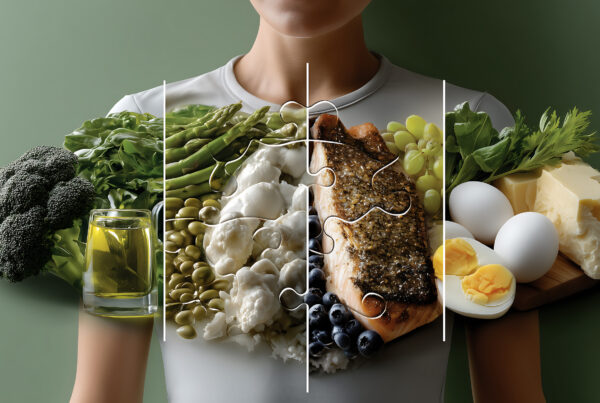”Question: What eating habits can I start immediately that will help me feel my best?
Reading time: 5 Minutes
MWi Hack:
- Learn how to create healthy eating habits that are sustainable and reasonable.
MWi Summary:
- Healthy eating can be defined in many ways, and these over-arching concepts can help you find a way of eating that works for you and your goals:
- Focus on the positive: what foods you can eat versus the ones you are choosing not to eat
- Ditch the labels: avoid using “good” and “bad” to describe foods
- Fuel up on nutrients: water, minerals, vitamins, carbohydrates, fats, and proteins
- Set yourself up for success: plan ahead
- Make changes that stick: SMART goals or smaller actions can help you be successful
If you asked 10 people to define “healthy eating,” you’d receive 10 different answers. While many of those answers may contain some truth, navigating what healthy eating means for you takes time, intuition, and many times, a game plan.
To begin, understand that “healthy” is often used as a catch-all phrase, intended to steer you toward products that may or may not actually help you achieve sustainable health. When you’re looking for habits, tips, and ingredients to help you feel your best, get more specific—what vitamins, nutrients, and flavors do you want to add to your weekly meal plan? Those granular questions can provide a more clear focus than “healthy” sometimes does.
If you’re looking to commit to an eating style that’s focused on helping you feel your best, it’s worth brainstorming some strategies that encourage certain habits to stick. Remember, eating should not feel restrictive or complicated. You can eat all of the foods you love while adding a variety of nutritious foods that fuel you and support the optimal functioning of your body.
Focus On the Positive
When you want to implement eating habits that work toward sustainable health, not a temporary “diet,” it’s essential to focus on the positive. People sometimes get caught up in what they cannot have now that they are eating “better.” This mindset makes you feel that you’re restricting yourself, which may lead to abandoning your new eating habits altogether.1
Instead, try focusing on what you’re adding to your menu, rather than what you feel you should avoid. For instance, try adding a new vegetable or fruit each week. Plan a meal with a new-to-you or rarely-eaten nutritious ingredient and experiment with new recipes.
Another example is to focus on adding more—such as increasing your water intake, eating more fruit, vegetables, whole grains, lean protein, and dairy. You don’t have to eliminate any of your favorite foods; simply focus on adding more nutrient-dense ingredients at each meal.
Instead of self-talk that focuses on what you “shouldn’t” have, the main objective of your eating choices is to increase your consumption of foods (and water!) that make you feel more energized, vibrant, and excited about meals.
Ditch the Labels
Similarly, ditching the labels that you and society at large may have put on ingredients ,such as “good” or “bad,” can relieve anxiety associated with making new choices regarding food.
Knowing that all foods are acceptable in moderation and that if you are craving a piece of chocolate cake, for example, you can enjoy it without guilt as part of an overall nutritious diet, helps create more balance in your approach to healthy eating.2
Labeling food as good or bad is an inherent part of diet culture—the pervasive belief that food is transactional and can be earned with strict eating behaviors or exercise.
Labeling food as good or bad often extends to labeling yourself as good or bad depending on whether or not you resisted the foods deemed off-limits. This way of viewing food and yourself is unhealthy and can lead to more significant food and body image issues.3
Food is cultural, social, and pleasurable. Avoid a mindset that makes you believe you have to restrict foods you love in order to be considered healthy. There’s room for all foods in a healthy diet.
Fuel Up on Nutrients
Choosing to create eating habits that make you feel good doesn’t have to be complicated. Fad diets and restrictive eating patterns are not necessary! Instead, focus on getting enough nutrients so you can feel your best. Nutrients include:
Macronutrients are carbs, proteins, and fats and are the overarching building blocks of all foods.4 Each is necessary for fueling your body, repairing structures, regulating and producing hormones, transporting and absorbing micronutrients, and more.
Micronutrients are vitamins and minerals which each play a role in your body. Phytonutrients are chemical compounds that provide a wide range of health benefits to your body and are obtained by eating plenty of plant-based foods.5 These compounds include flavonoids, phytochemicals, flavones, isoflavones, catechins, and anthocyanidins.
Set Yourself Up for Success
Part of setting yourself up for success includes planning ahead and changing your environment to reflect your goals. With any lifestyle change, the more you can do ahead of time to help yourself be successful, the better.
Here are some ways you can set yourself up for success:
- Buy a wide range of nutritious foods to have on hand (and keep in sight).
- Set aside one or two days a week to prepare nutritious meals and snacks ahead of when you’ll need them. Meal planning can increase the likelihood of consuming more nutrient-rich food.
- Keep nutritious snacks in your bag or at your desk.
- Fill a water bottle to keep at your desk during the day—set phone reminders to drink water, if necessary.
- Cut up or bulk cook things like veggies and grains to make meals faster and easier to assemble.
- Plan to enjoy foods you love! Understand that a well-rounded diet is a healthy one.
Make Changes that Stick
Making small changes instead of completely overhauling your entire eating style makes it more likely for those changes to stick and become a lifestyle.7 One way you can make changes that stick is to use SMART goals—specific, measurable, attainable, relevant, and time-bound.
Using SMART goals is a tried and true method of turning habits into a lifestyle. Here is how to set SMART goals.
- Specific: Choose specific habits that support your desired outcome. Instead of saying, “I want to eat healthier,” try saying, “I want to eat a new vegetable at dinner three nights per week.”
- Measurable: Whatever your goal, be sure that it is trackable and quantifiable. Whether that’s how many days per week you bring lunch to work instead of eating out or how much water you drink each day, make sure you can measure it!
- Attainable: Your goals should be realistic and achievable. To ensure this, make your goals short-term and reasonable for your current lifestyle. Don’t overcommit. A goal such as such as “I will increase my serving of lean protein at breakfast,” is easy enough to achieve while still being challenging enough to work toward.
- Relevant: Your goals and eating habits should be pertinent to your personal preferences. For instance, if you really dislike most vegetables, choose another eating goal that motivates you instead of forcing yourself to eat them. Perhaps you want to increase your daily fiber intake. Set a plan for how many grams per day and stick to it. Choose a goal that feels motivating to you.
- Time-bound: Create a timeframe in which you commit to reaching your goal. Of course, the timeframe should be realistic and not too distant. Starting with a few weeks ahead is ideal. Once you’ve reached the time set, re-evaluate your success and continue to set goals.
Seek Out Support
Creating a support system through your social network of friends and family may help increase overall wellbeing and adherence to health goals, including nutritious eating practices.8 Letting your friends and family know that you are committing to some lifestyle changes—no matter how big or small they may be—could make it easier to stick to your goals.
Asking the other people in your home, for instance, to help with meal preparation, brainstorming nutritious foods to try, or grocery shopping might take some of the load off of you and get them involved.
Nutrition and fitness books also can help guide you through the process, and cookbooks can provide all the inspiration you need.
MWi would like to thank Rachel MacPherson, BA, CPT for sharing these insights with our community. Click the button below to go to the original article:






